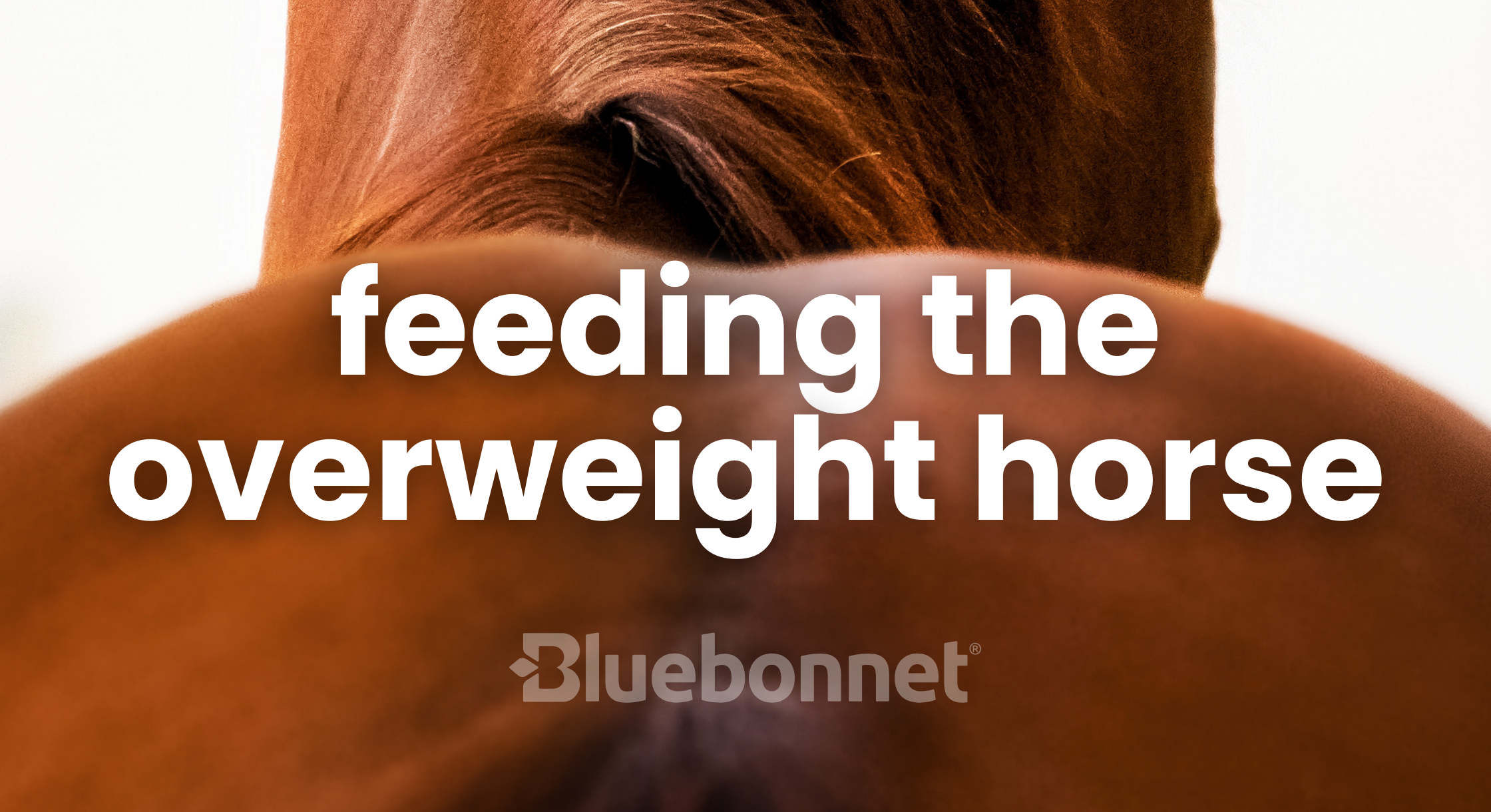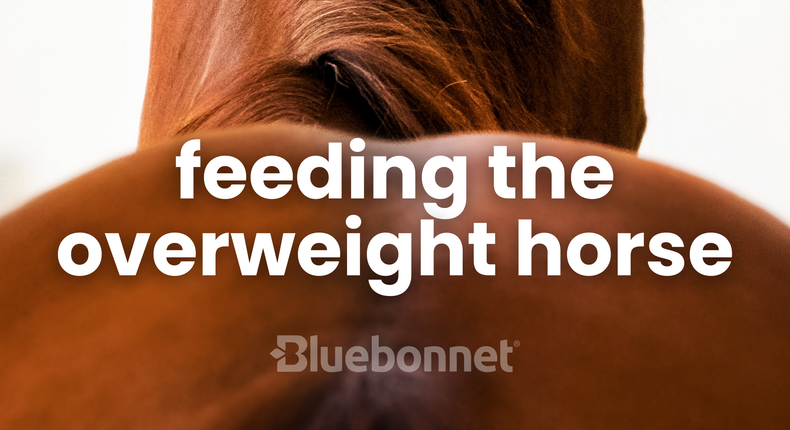
Over 50% of horses are considered overweight, with 20% falling into the "obese" category.
Obesity in horses may seem like an innocent problem, but the negative effects can pile-on quickly - and be difficult to reverse.
Helping your horse maintain ideal weight isn’t just about looks. Excess weight puts a strain on their entire body, impacting performance, longevity, and overall wellbeing.
- Joint & Hoof Health- Any extra weight means a harder impact for the legs and often decreased circulation - multiplying the risk of joint disease, soft tissue injury, and laminitis.
- Cardiovascular Stress- When heart tissue starts to become infiltrated by fat, horses not only struggle with normal exercise - but are at a much higher risk for hypertension and heart attacks.
- Hormonal Imbalance - Overweight horses produce more of the stress hormone cortisol, placing them at risk for developing metabolic disorders, behavioral vices, and even gastric ulcers.
- Respiratory Strain- Obesity can lead to a lower lung capacity as excessive fat accumulation compresses the chest cavity, restricting the lungs' ability to fully expand while breathing. More weight also means more tissue to which oxygen needs to be delivered - increasing the overall demands on the body.
How do I know if my horse is “too fat”?
Use this simple system to estimate your horse’s weight, if you don’t have access to a scale.
Next, examine your horse’s body to evaluate their Body Condition Score, or BCS. According to the Henneke scale (1-9), horses scoring from 4-6 are considered ideal, and those scoring 7-9 are considered overweight to obese. Remember to reference standards specific to your horse’s breed, age, and activity level- an ideal body condition will look different for a racing thoroughbred, or a draft horse. .
My horse could lose a little weight, now what?
Feeding for weight-loss is more complicated than cutting back calories. Helping your horse return to their lighter, happier selves starts with reevaluating what they eat. Beginning with adjusting forage intake, then making sure your horse is still receiving essential nutrients to support a healthy body.
As an owner, try to be patient. Weight-loss is a slow process for horses. The difference between BCS scores is about 45-50 pounds for the average 1,100-pound horse. For most horses, it can take around two months to safely lose that much weight. Consistency is key, and will keep you and your horse on track toward your goals
BUT FIRST, FORAGE
Supply enough forage…but not too much
Most horses should receive a minimum of 1.5% to 2% of their body weight in forage every day. This means hay and/or pasture. For a 1000 lb horse, this works out to 15 - 20lbs.
Remember though, weight-loss requires your horse to be in a calorie deficit - which means they need to be expending more energy every day, than they’re consuming.
When it comes to weight-loss, you will want to feed on the lower end, to around 1.5% of their body weight. If your horse requires faster weight-loss, work with your veterinarian to determine the safest approach to feeding less forage. In extreme cases, they may recommend cutting back closer to 1%.
Provide 24/7 access to forage… if at all possible
Horses are designed to graze continuously throughout the day and night.Too much time with an empty stomach can cause ulcers, anxiety, and other health challenges.
Try to stick with long-stem forage, like hay. Replacing hay with hay cubes/pellets has been shown to reduce chewing time by an average of 75%, increasing the risk to your horse.
It’s recommended that horses never go more than 4 hours without long stem forage passing through the gut.
Slow them (way) down
A great first step in managing the overweight horse is to control forage intake, with a slow feeder or hay net. Feeding less hay means you’ll need to slow them down as much as possible. Look for hay nets and feeders with extra small holes, so your horses take smaller bites. One of our favorites is the “1 Inch Slow Feed Extreme” net from Hay Chix®. If your horse doesn’t do well with hay nets, try feeding smaller meals throughout the day.
Choose hay wisely
Alfalfa has many great benefits, like higher levels of calcium that acts as a stomach buffer. However, it’s also much more nutrient-dense than most grass hays. That means more calories in every bite. For that reason, it is typically recommended to feed minimal or no alfalfa to an overweight horse.
Unfortunately, this also means that your horse will likely not be getting enough of the vitamins and minerals typically covered by alfalfa. You’ll need to supply these through a feed or diet balancer - but more on that later.
Look for a mature hay, such as bermuda grass, that has fewer calories per pound. Maturity stage at time of harvest, growing conditions, and plant species all play a role in the nutritional content of your hay. The only way to truly know the calorie and sugar content of any hay is to have it tested.
Manage pasture grass
Since it’s hard to measure exactly how much grass your horse is eating during their pasture-time, it’s often recommended to put horses on a drylot with their hay net.
If you don’t have access to either, you can also try a grazing muzzle or stall them for part of the day.
WHAT ABOUT FEED?
Conventional feeding practices will usually incorporate a fortified feed, to cover gaps in essential nutrients or supply extra energy.
Let’s be honest…feed is also delicious and makes our horses happy, which makes us happy. While you may be eager to provide these options for your equine partner, the excess calories (to an already overweight horse) put them at risk. Extra caution should be taken with horses who already struggle with obesity and are more prone to metabolic disorders.
Don’t fret, there's an alternative solution to completing your horse’s feed program - diet balancers!
When feeding to “trim up”, a diet balancer may be the perfect solution, providing necessary nutrients without sacrificing your lower calorie goals.
Essentials, always
No matter what, your horse still requires vital vitamins, minerals, and amino acids. For horses on restricted diets, nutrient deficiencies are always a risk. While your horse may lose weight, the health of their immune system, digestive system, joints, hooves, skin, coat, and more can decline without fundamental nutrients.
“Weigh” your options
Quality diet balancers use concentrated formulas and low daily feeding rates, to deliver all the necessary nutrients a horse needs - with fewer calories.
Some diet balancers, like Bluebonnet’s Pro Balance contain prebiotics and probiotics that act as digestive boosters and allow for better nutrient utilization.
A diet balancer is a great option for most horses. Paired with a suitable exercise routine and quality forage, your “plump pony” can slim-down in no time.
5 STEPS TO FEED FOR HEALTHY WEIGHT- LOSS
- Monitor your horse's body condition and weight.
- Focus on forage first, by feeding an appropriate type and amount based on your horse’s needs. Use hay nets to extend eating time when cutting back.
- Limit access to pasture grass, by moving your horse to a drylot. Alternatively, temporarily limit turnout or try a grazing muzzle.
- Cover essential vitamins and minerals with a low-calorie solution like Pro Balance
- Work with a veterinarian or equine nutrition consultant to assess your horse's specific needs and develop a tailored feeding plan.
With the right approach, you can help your horse achieve and maintain a healthy weight.
Research references:
1 - Carter, R., Geor, R., Staniar W., Cubitt, T., Harris, P. Apparent adiposity assessed by standardized scoring systems and morphometric measurements in horses and ponies,The Veterinary Journal, Volume 179, Issue 2, 2009, Pages 204-210, ISSN 1090-0233, https://doi.org/10.1016/j.tvjl.2008.02.029
2 - Hart, R., Farmer, J., Bailey, A., Duberstein, K. 103 Chew frequency and duration in horses consuming bermudagrass hay in slow feeders as compared to loose hay, Journal of Equine Veterinary Science, Volume 124, 2023, 104405, ISSN 0737-0806, https://doi.org/10.1016/j.jevs.2023.104405.
3 - Pratt-Phillips, S.E., Owens, K.M., Dowler L.M., Cloninger, M.T. Assessment of resting insulin and leptin concentrations and their association with managerial and innate factors in horses. Journal of Equine Veterinary Science 2010;30:127–133.
4 - Shepherd, M., Harris, P., Martinson, K.L. Nutritional Considerations When Dealing with an Obese Adult Equine. Vet Clin North Am Equine Pract. 2021 Apr;37(1):111-137. doi: 10.1016/j.cveq.2020.12.004. PMID: 33820604.
5 - Siwinska, N.; Janus, I.; Zak-Bochenek, A.; et al. Influence of Obesity on Histological Tissues of the Cardiovascular System in Horses, Animals 2022, 12, 732; doi.org/10.3390/ani12060732
6 - Thatcher, C.D., R.S. Pleasant, Geor R.J., and F. Elvinger. Prevalence of Overconditioning in Mature Horses in Southwest Virginia during the Summer. Journal of Veterinary Internal Medicine 2012; 26:1413–1418

